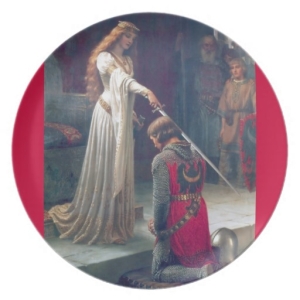Is a Fons Honorum Necessary?
 An interesting debate in the Knights Templar world is whether a Fons Honorum (fount of honor) is necessary in a Knights Templar Order?
An interesting debate in the Knights Templar world is whether a Fons Honorum (fount of honor) is necessary in a Knights Templar Order?
The fount of honour (Latin: Fons Honorum) refers to a person, who, by virtue of his or her official position, has the exclusive right of conferring legitimate titles of nobility and orders of chivalry to other persons. There are several types of Fons Honorum. Two examples are that of a Sovereign Order administered by a Monarch and an Ecclesiastical Order that has a religious figure as its protector and patron.
Beginning in 1118, the Knights Templar existed for their first 11 years with no Fons Honorum. Knight Commanders were simply able to Knight new members into their Order. Only after the Council of Troyes in 1129, did the Pope give his recognition to the Kngihts Templar and they became an Ecclesiastical Order called a Papal Order of Knighthood. In 1312, the Pope officially withdrew his Ecclesiastical recognition of the Knights Templar. It is our argument that the Knights Templar would then default to their first 11 years of not requiring a Fons Honorum for Knighting.
Even though the Knights Templar had been exclusively an Ecclesiastical Papal Order (the Templars were answerable only to the Pope), there is a prominent Neo-Templar Order today that uses a member of a formerly sovereign family as it’s “Fons Honorum.” The obvious problem with this is that the Knights Templar were never administered by a Sovereign but only by a Pope. The second problem is that the royal family member they have chosen is no longer a Sovereign of any nation. To be valid, the Knighthood from a Sovereign must be administered by a Monarch that is currently the reigning Sovereign of a nation and not a former Sovereign. Only if this prerequisite is met, can the order be considered to be a recognized order by nature (3).
Some argue that during their first 11 years (before their Papal recognition in 1129), the Knights Templar pledged their allegiance to King Baldwin II. This is certainly true and King Baldwin II provided them their famous home on the Temple Mount in 1120. But the Templars didn’t use King Baldwin II as their Fons Honorum because the concept of “Fons Honorum” didn’t even exist for another 111 years until Frederick II (King of Sicily) invented this concept sometime between 1231-1250 (2) (1). Military Orders knighted new members irregardless of whether they held an allegiance to a king because the kings name was not invoked into the Knighting ceremony like it was after the concept of the “Fons Honorum” was invented.”
Today, some wrongly assume that the concept of “Fons Honorum” has always been around but it is a relatively recent invention of Sovereigns to subjugate Knights to their Royal power (1) (See: http://en.wikipedia.org/wiki/Fount_of_honour). Even after the concept of “Fons Honorum” was invented sometime between 1231-1250, many of the old-style military orders resented what they considered to be a royal encroachment on their independence (a trick by the royals to consolidate their power over the independent process of creating Knights).
It is our contention that since the Knights Templar of today are devoid of their Papal recognition, they then default to their first 11 years of not requiring a Fons Honorum for Knighthood. It is ironic that the very concept of “Fons Honorum,” that the ancient Knights Templar would have resisted as royal subjugation, is now embraced by a Neo-Templar Order in their attempt at legitimacy. Lest we forget, it was a Royal (King Philip IV of France) who almost destroyed the Templars because he feared what he could not control and owed them a debt he could not repay. Clearly, it would be historically contradictory to try to use a Royal Sovereign as a Fons Honorum for a Templar Order with two exceptions. The Pope gave the right to the Kings of Portugal and Spain to rename the Templars and place them under their sovereign power: the Order of Christ and the Order of Montesa, respectively.
References
(1) https://en.wikipedia.org/wiki/Fount_of_honour
(2) Until some time in the thirteenth century there were parts of Europe where a baron, lord or enfeoffed knight might dub an esquire, the parrain thus raising the young man to knighthood. In most of western Europe this practice was abolished by 1250. When Frederick II, who ruled a wide swathe of Europe from Saxony to Sicily, declared that only the son or grandson of a knight could become a knight except by his royal license. http://www.regalis.com/malta/knights.htm
(3) Thus, it is problematic when an order is founded by a formerly sovereign, but no longer regnant House. By the same token, the patronage of a former reigning dynasty has to be considered as merely decorative and does not bestow any rights. An “order” thus requires a sovereign act of creation and ensuing sovereign recognition. Only if this prerequisite is met, can the order be considered to be a recognized order by nature. http://www.st-lazarus.us/GPA/References/Docs/fons_honorum.pdf

Recent Comments